Deer Management: 10 years of monitoring
Boughton Estate's forestry department has been undertaking systematic deer impact and cull monitoring over 10 years.
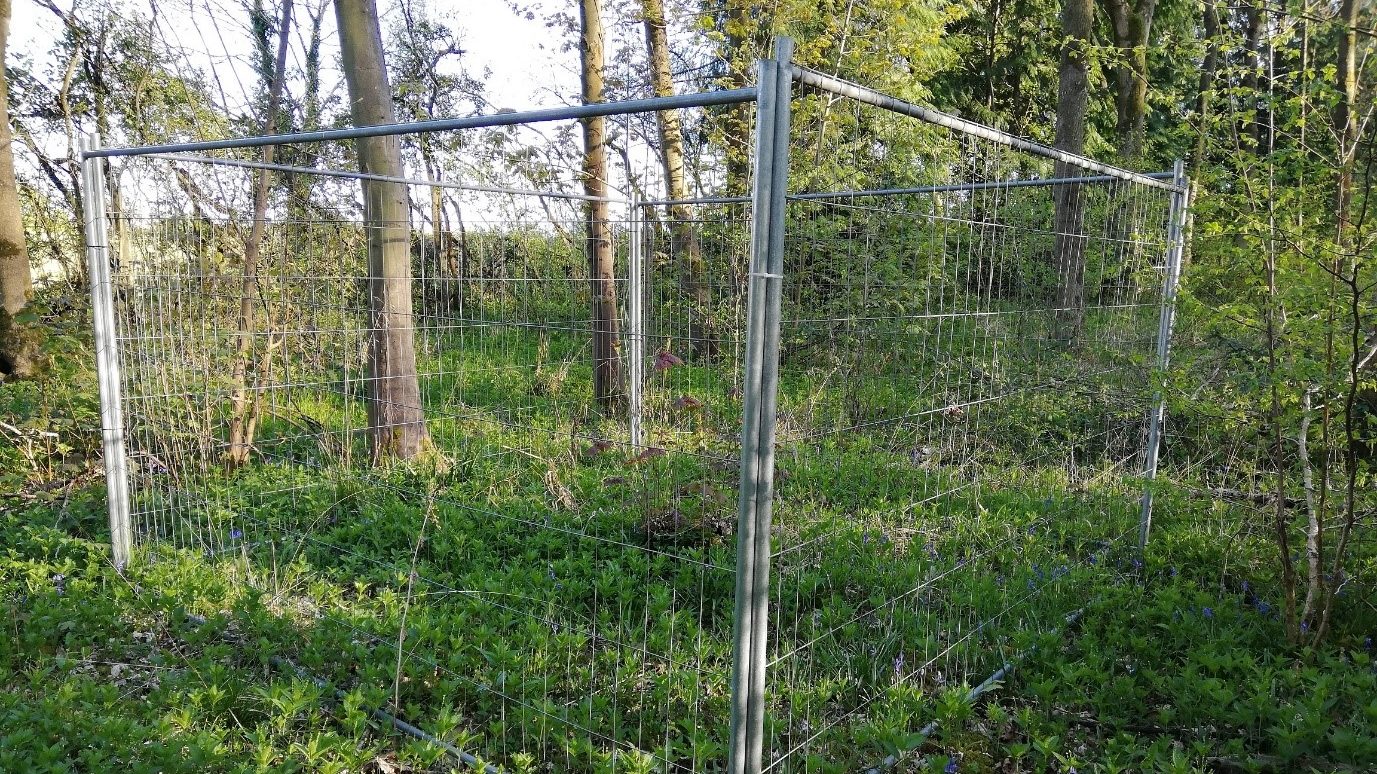
Case Study 2020
Boughton Estate, Northamptonshire (part of the Buccleuch Group)
Boughton Estate comprises large remnants of the historic Rockingham Forest. Woodland cover on the 4,400ha estate is around 22% (1,000ha), split into four main blocks with additional spinneys and farm woodland blocks.
The woodland is managed by the group’s forestry department, Buccleuch Woodlands, to provide a sustainable surplus of timber for sale and a landscape attractive to other non-forestry activities. Annual timber production is around 4-5000tonnes but recent Ash clearance has doubled this. The estate aims to run the woodland on a continuous cover forestry policy (CCF) but high number of fallow deer, muntjac and the occasional reappearance of roe deer add to challenges.
Three of the largest blocks are classed as Ancient SemiNatural Woodland (ASNW) with the remaining large block on former quarry land which would previously have been ASNW. The ASNW areas are under a Countryside Stewardship Scheme (CS) and all the woodland is certified to the UK Woodland Assurance Standard (both FSC and PEFC).
10 years of monitoring deer damage
Sustainable forest management requires recruitment of young trees at a level where the forest does not diminish. Deer damage to young trees was leading to increased tree establishment costs, reduced non forestry commercial activity such as bushcraft, horse and cycling events and jeopardising UKWAS status which requires proven and effective deer management. The estate’s forestry department has been undertaking systematic deer impact and cull monitoring over 10 years.
The original in-house deer management resources were centred around client and let stalking, and managed by the game department. However, the economic risks from losing FSC status and CS grant funding, as well as increased timber production costs, were outweighing financial returns from this sporting activity.
A new approach
In 2015 it was decided that deer control would move to the forestry department and away from the game department. This allowed a greater focus of effort on reducing deer numbers before the onset of winter proper, a period when the previous regime traditionally had other priorities, and so more effectively reduce the pressure on the woodland at its most vulnerable time.
A contract based around an effective reduction cull was won by Mike Cundy Deer Management Services (MCDS) who had a pool of very qualified and experienced deer managers to call upon. Deer management now takes place every other weekend over the fallow deer season to allow deer to maintain their natural behaviour and not overstress them.
Measuring success
The main metric for assessing the success of the deer management plan is by damage monitoring.
Two similar sized areas containing woody shrubs in close proximity to one another are pegged out. On one, a square of ‘Heras’ type fencing is erected, the ‘control’, and on both the shrubs are cut down to ground level. The relative growth rates are then systematically recorded in July, November and March. The plots are then moved to a new location and the process repeated.
This is acknowledged as a fairly basic approach, but is easy to use and apply. One point to note when monitoring is to know the difference between deer and other grazers e.g. hares, which may gain access.
Deer impact scores are taken from the disparity in height of the vegetation between the fenced and unfenced plots and given a score from 0 – 4, with 0 (no damage at all) to 4 (all regrowth being almost eaten off). A note is kept of the conditions experienced during the monitoring season e.g. very cold/mild winter, which will help interpret results.
Using this scoring method, a damage score consistently below 2 would give the woodland management team options as to whether tree protection, other than deer fencing, is sustainable.
The results show damage levels were consistently approaching 3 prior to 2015, meaning unacceptable levels of deer impact on the woodlands.
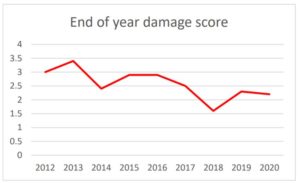
The score has declined significantly since 2015 and it has now become possible, in areas away from the main woodland blocks, to establish trees without resorting to deer fencing if less palatable species are chosen e.g. conifers, Birch, Alder.
Within the main woodland blocks deer fencing will be the default option on restock sites for the foreseeable future.
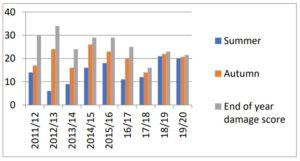
However, in areas where the regeneration is very prolific (Sycamore, Hornbeam) young trees can be seen to be getting to height to escape the predation of deer. Other benefits are less pressure on the ground flora meaning that the estate woodland can better meet its UKWAS and CSS requirements and produce a more attractive woodland for non-forestry commercial activities.
Under the new regime, although the estate is experiencing increasing levels of deer immigration over the summer, they are quickly brought under control as soon as the season opens. The damage subsequently does not increase over the rest of the monitoring period.
Resources
Deer numbers culled per year quickly climbed as the new deer management group got to know the land. Muntjac numbers culled were significantly up as there was no real financial incentive to target the more valuable animals (whether physical size e.g fallow, or, trophies).
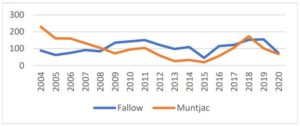
Above: Deer numbers by species culled over time
Over the contract period the success rate of the deer managers has been between 0.7 falling to 0.5 deer culled per outing (an outing being a morning, or, an evening stalk).This has meant the contract manager has had to provide between 200 – 400 man days (a ‘man day’ being a morning and evening stalk combined) per year. 2019/2020 however proved a difficult year with extreme wet weather, difficulty in selling venison carcasses at a fair price and Covid-19.
Deer Management Plan
The Forest Manager draws up the annual deer management plan and coordinates the monitoring.
Annual maps showing what was culled and where are a useful tool to highlight potential areas where a reallocation of resources may be.
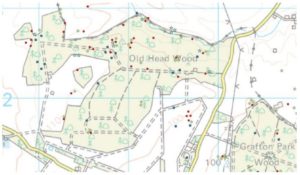
Above: Map showing deer by species and sex culled
between 01/08/18 to 31/04/19 in Old Head Wood. Green
square – Fallow Doe. Red dot – Fallow Buck. Blue
square – Muntjac Doe. Blue star – Muntjac Buck
The map above is of the past two years effort centred on Old Head Wood.
Such maps help assess:
• Why some seats have not produced the numbers culled in previous years
• How many man days were needed to produce the cull totals
• The significance of the change in number and sex of each species culled
• What impact areas of clear felling and thinning during late 2019 had on the effectiveness of the Deer Managers
Fallow deer range across wide areas crossing estate boundaries, although they do follow patterns which can be exploited. Maps indicate where more effort may be usefully applied, and may highlight reasons for the lack of activity, such as housing, poor access or forestry operations.
Over the cull period the weight of carcasses across species and sexes stayed constant suggesting there had been no excessive competition for food resource at any one time.
Deer numbers culled are expected to plateau out at around 150-200 fallow a year with the more territorial muntjac down to 50-100.
To meet the aims of the deer management plan the deer cull numbers need to be maintained, and in some areas increased, if the long terms aims of the forestry department are to be met.
Landscape control and new technologies
The estate is trying to work with neighbouring land owners on a landscape approach.
The adoption of new technologies, such as hand held thermal imagers has increased the efficiency of Deer Managers. Anecdotal evidence on the estate suggest that efficiency is increased by up to 50% depending on species, time of year, etc.
Main findings
• Effective deer management requires allocation of suitable resources by both the Deer Manager and the land owner. It is initially likely to be a
cost operation, although if successful this cost is more than offset by more commercially viable woodland
• In any one year, culling as great a proportion of deer as possible in the early part of the season and certainly before Christmas will have a beneficial effect of lowering the overall deer impact on the woodland
• Communicate clear goals to the Deer Managers and make sure all involved have the resources needed. This is most effectively communicated in a concisely written deer management plan that is regularly reviewed
• Engage the most highly qualified and experienced contractors possible
• Both sides must be committed to a number of years to see sustainable results
• Regular communication between parties is key
• Objective ongoing deer impact monitoring and wider record keeping are essential to maximise the effectiveness of deer control
• Application for a night licence has not yet been seen as necessary although this remains an option.
For more on this programme contact:
Jonathan Plowe, Forestry Operations Manager, Boughton Estate
jplowe@buccleuch.com
With thanks to Buccleuch woodlands, Mike Cundy and the Boughton Deer Management Team for this Case Study

